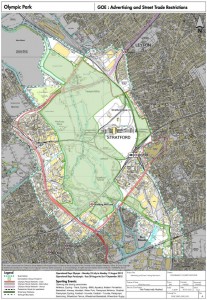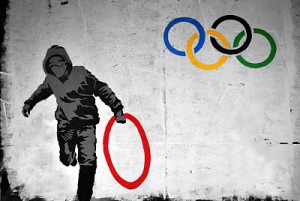Imagine you are in a city that is known for its rich history and culture, yet as you walk down the street all you see are the same five or six logos and company names. These companies represent some of the major global brands known for their wide reach and deep pockets and they are everywhere. You start to realize that your choices regarding what beverage you can drink, what shirts you can buy and what credit card you are allowed to use is limited to these select brands. There is even a “brand police” organization that ensures local businesses aren’t displaying signs or logos that may compete against these behemoth brands. Even logos on soap and paper towel dispensers in bathrooms are covered in an attempt to keep the focus on only these approved brands. It sounds like scenario that belongs in George Orwell’s dystopian novel, 1984, but it’s really a reality that’s happening right now in London and there is nothing anyone can do to stop it.
The upcoming London Summer Olympic games have already changed the landscape of the historic city. Construction of new arenas, an Olympic park, and the world’s biggest McDonalds are impressive reminders of the impending events, but it’s the strict brand exclusion zones surrounding these Olympic venues that serve as the real indicator of the level of control Olympic organizers have over the city. These zones fall under the domain of the London Organizing Committee of the Olympic Games (LOCOG), and their job is to create a brand twilight zone where all advertisements and brands are strictly monitored to ensure you only encounter those select few who have become official sponsors of the games. Part of the International Olympic Committee’s (IOC) requirements for hosting the games requires bidding governments to introduce new legislation that goes above and beyond existing copyright and contract laws to offer increase protection to the game’s official sponsors (Addley, 2012; Hall, 2012). Many are calling London’s brand laws and limits stricter than those imposed by communist China in 2008 and see the LOCOG as setting a president for brand control in public spaces like no one has ever seen (Hall, 2012).
London’s brand exclusion zones are a 35-day, one kilometer perimeter around all Olympic venues that are stringently monitored to ensure all advertising and brands seen by any spectators, athletes and broadcast cameras are IOC approved (Hall, 2012; Kosmograd, 2012). The corporate sponsors protected by the committee represent a combined $1billion in sponsorship dollars that have been paid to the to become official partners of the games (Hall, 2012). The group includes such well-known names like McDonalds, Coca-cola, and Adidas and they want to ensure that they are getting the most for their sponsorship money (Hall, 2012). To do this, the LOCOG’s “branding police” have made sure that only Olympic sponsors have the opportunity purchase advertising, both indoor and outdoor, in the designated zones (Addley, 2012;McCabe, 2012; Dicker, 2012). Other rules and regulations aim to outlaw any unauthorized association with the games or competition against official sponsors by local businesses (Addley, 2012; Hall, 2012, Dickers, 2012). In addition to the ensuring the Olympic name and ring logo is not besmirched by local establishments, the new laws have made it so businesses who fail to pay for the privilege of using such terms like “games,” “2012,” or even the words “medal” and “gold,” will risk prosecution and large fines at the hands of LOCOG (Hall, 2012; Addley, 2012).
Are these new laws crossing the line and infringing on the rights of local businesses and the city itself (Kosmograd, 2012)? The new laws and regulations put local businesses in a particular quandary as many are too small to compete with large corporate sponsorships but also face so many IOC do’s and don’ts about branding that they are at a loss as to what they can actually do to capitalize on this Olympic opportunity (Addley, 2012). For example in the Olympic Village, McDonalds will be the only branded food outlet available and Visa is the only payment card accepted making it nearly impossible for visitors to seek out or even find alternatives (Kosmograd, 2012). Some fear that the brand limits the LOCOG enacted to secure the sponsorship contracts are having an adverse reaction of stifling the economic benefits available to local businesses (Addley, 2012; Kosmograd, 2012).
The LOCOG insists the limits are in place not only to protect corporate sponsors but to prevent the occurrence of ambush marketing at the games (Kosmograd, 2012; Dickers, 2012; Addley, 2012). Ambush marketing is a form of guerrilla marketing where companies try to promote their brands at events without paying sponsorship fees (“Playing the game; Ambush marketing,” 2012; Addley, 2012). The “brand police” have also extended their reach online, as social media will also be monitored as much as possible to protect the Olympic brand (Addley, 2012). Esther Addley’s (2012), article in The Guardian outlines how even athletes are getting a crash course in the what they can and can’t post or blog about during the games, while Twitter and the LOCOG have formed an agreement aimed at “barring non-sponsors from buying promoted ads with hashtags like #London2012” (p1). Clearly the Olympic committee is taking the issue of branding seriously by pulling all the stops to ensure visitors, viewers and social media users have a consistent on-brand Olympic experience or should I say a consistently corporate-sponsored Olympic experience.
Is the LOCOG going too far, have they over-stepped their boundaries by creating geographic zones that have essentially been scrubbed of all local and non-sanctioned advertising and brands? Not surprisingly the committee doesn’t think so and cites the fact that these corporate sponsorships helped pay for the games themselves by filling in funding gaps that otherwise would have fallen on the city and its citizen’s shoulders (Addley, 2012; Ha1l 2012). Many are reeling at the lengths the games organizers are going to in enforcing these rules, citing a special website where athletes are encouraged to report any potential ambush or sponsorship infringement activities they might see in the village (Addley, 2012). Some are calling the brand exclusion zones the “privatization of public space,” (Kosmograd, 2012) while others refer to the measures as “draconian” (Addley, 2012). Regardless of how intrusive the regulations may seem, it certainly does set a precedent on how local businesses and non-sponsor brands can be systematically shutout from tapping into these types of opportunities to reach new audiences and increase sales. It will be interesting to see how the games play out in the coming weeks and what new and inventive marketing techniques non-sponsor brands will cook up to circumvent the strict rules and regulations in order to bring the brand twilight zone back to reality.
Sources:
Addley, E., (2012, April 13). Olympics 2012: Branding ‘police’ to protect sponsors exclusive rights. The Guardian. Retrieved June 08, 2012, from http://www.guardian.co.uk/sport/2012/apr/13/olympics-2012-branding-police-sponsors?INTCMP=SRCH
Dicker, R. (2012, May 29) London 2012: Olympics advertising tightly enforced. The HUffinton Post. Retreived June 09, 2012, from http://www.huffingtonpost.com/2012/05/25/london-2012-olympics-sponsors_n_1546466.html
Hall, E. (2012) London outdoes China in brand crackdown at summer Olympics. AdAge. Retrieved June, 08, 2012, from http://adage.com/article/global-news/brand-police-full-force-london-olympics/235136/
Kosmograd. (2012). Olympics brand exclusion zone. Retrieved June 08, 2012, from http://newsfeed.kosmograd.com/kosmograd/.
McCabe, M. (2012) Locog to open Olympic outdoor action to non-sponsors. Marketing Magazine. Retrieved June 09, 2012 from http://www.brandrepublic.com/news/1114677/Locog-open-Olympic-outdoor-auction-non-sponsors/?DCMP=ILC-SEARCH
“Playing the game; Ambush marketing.” The Economist [US] 5 July 2008. Academic OneFile. Web. 10 June 2012.



3 Responses to You Are Now Entering The Brand Twilight Zone.